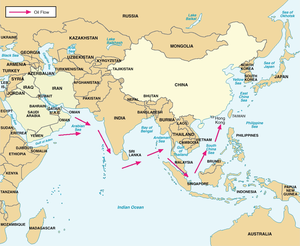
Summary
Sea lines of communication (abbreviated as SLOC) is a term describing the primary maritime routes between ports, used for trade, logistics and naval forces.[1] It is generally used in reference to naval operations to ensure that SLOCs are open, or in times of war, to close them. The importance of SLOCs in geopolitics was described in Nicholas J. Spykman's America's Strategy in World Politics published in 1942.

In the American Revolutionary War and the Napoleonic Wars, the SLOCs were, for the most part, in the control of the British Navy. When the British lost control of them during the Revolution, the result was the fall of Yorktown and its biggest army and, ultimately, the war. In the Napoleonic era, maintaining belligerence throughout, the British embargoed and blockaded any country associated with Napoleon, which created large economic hardships and dislocations that played a part in people of France becoming disenchanted with Napoleon.
In World War I and World War II, the British and Germans declared mutual blockade and the Kriegsmarine attempted to close the SLOCs from North America to the British Isles with the use of submarines. In each case the Allies succeeded in keeping the sea lanes open. The Germans in each case failed to defeat the British naval blockade of Germany. The United States Navy in World War II successfully closed the SLOCs to Japan, strangling the resource-poor island nation.
Had the Cold War turned hot, Europe would have required resupply and reinforcement from North America. The Soviet Navy could potentially threaten and contest Atlantic SLOCs to support ground offensives in Europe.
See also edit
References edit
Further reading edit
- Mahan, Alfred Thayer (1890). The Influence of Sea Power upon History: 1660–1783.
- The full text of The Influence of Sea Power upon History at Wikisource
- Phelan, George R. (1954). "Sea Power and Strategies for the Control of the Seas". Naval War College Review. 6 (10): 15–37. ISSN 0028-1484. JSTOR 45104663.
- Underwood, G.L. (1981). "Soviet Threat to the Atlantic Sea Lines of Communication: Lessons Learned from the German Capture of Norway in 1940". Naval War College Review. 34 (3): 43–47. ISSN 0028-1484. JSTOR 44642156.
- Noer, John Halvard (1996). Southeast Asian Chokepoints: Keeping Sea Lines of Communication Open. National Defense University, Institute for National Strategic Studies.
- Peele, Reynolds B. (April 7, 1997). "Maritime Chokepoints: Key Sea Lines of Communication (SLOCs) and Strategy". Homeland Security Digital Library. Army War College (U.S.).
- Claxton, Karl (February 20, 2014). "China's sea lines of communication—implications for the South Pacific?". The Strategist.
- Kim, Meoung-Sung (2015). "Sea Lines of Communication Security and Piracy". Strategy21 (in Korean). 36: 150–179. doi:10.22803/strategy21.2015.s36.150. ISSN 1226-9212.
- The Future of Sea Lane Security Between the Middle East and Southeast Asia (PDF), Energy Studies Institute, Chatham House, June 23–24, 2015
{{citation}}: CS1 maint: others (link) - Andrews-Speed, Philip; Len, Christopher (February 2016), The Future of the US Security Umbrella for Sea Lines of Communication (SLOCs) between the Middle East and Southeast Asia, and the Future Role of China (PDF), Singapore: Energy Studies Institute
- Mubarok, Achmad Romadon; Putra, Agung Tri (2017), Protection of ASEAN Sea Lines of Communication in Maritime Perspective, 6th ICADA 2017 — SSIS
- Rimland, Benjamin (July 25, 2017). "Japan's Maritime Strategy and the Dynamics of Denial". Tokyo Review.
- Tarapore, Arzan (February 9, 2021). "India should prioritise a denial strategy in the Indian Ocean". The Interpreter. Lowy Institute.


